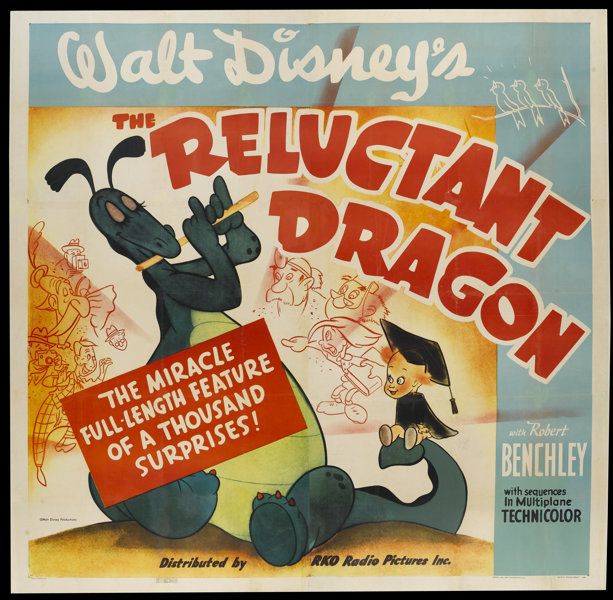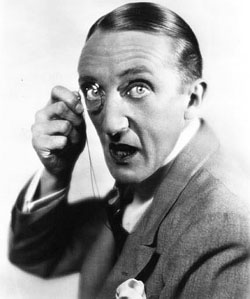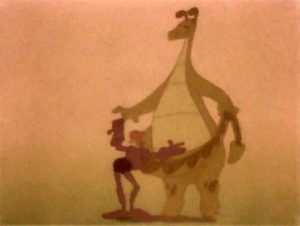



I’m taking a brief break from Tom and Jerry so I can rewatch several of the shorts in the wonderfully restored Thunderbean release. I’ve been told there’s some notable scenes, and I want to take a bit of time to update my previous articles before finishing the remainder of the series. During this pause period, in celebration of the Year of the Dragon, let’s discuss the 1941 Disney film, The Reluctant Dragon. It is important to note that this analysis will be split into two parts. The first part will focus on the dragon, Sir Giles, and masculinity.
Despite it being the film’s title, “The Reluctant Dragon” short does not occur until the end of the film. While one can easily watch the short on its own without needing a prior context, for those interested in how the short connects with the film as a whole, here is a simple plot synopsis. Robert Benchley (playing himself) is prodded by his wife (Nana Bryant) to try and sell the rights to the story, “The Reluctant Dragon.” After arriving at the Walt Disney Studio, he soon ditches his guide Humphrey (Buddy Pepper), and explores the lot. This adventure of sorts makes up the bulk of the film’s runtime, showcasing Disney’s technical achievements and promoting several upcoming works. Finally, Humphrey catches up with Benchley, and takes him to meet Walt Disney. Before Benchley can begin his pitch to Disney, he’s invited to watch a screening of a newly completed short. It’s none other than an adaptation of “The Reluctant Dragon” thus ending Benchley’s journey in selling the story rights.
Kenneth Grahame, most likely known for The Wind and the Willows published “The Reluctant Dragon” in his Dream Days (1898) short story collection. In general, Disney’s adaptation follows the story’s original plot. Though for simplicity’s sake, I shall focus on the original story synopsis, rather than the accuracy of Disney’s adaptation. A boy, who enjoys reading, learns one day from his father that a dragon is residing close to their village. The boy visits the dragon, but the creature differentiates from his book counterpart, preferring poetry over plunder. The villagers, however, want the dragon killed and Saint George (changed to Sir Giles in the Disney short) arrives to slay the dragon. The boy visits Saint George to persuade him not to kill the dragon, and then the two go and meet the dragon. The three discuss an alternate plan of staging a fake fight to appease the villagers. The plan is a success, and after Saint George has “conquered” the dragon he gives him a talk about his behavior. Later, Saint George announces to the crowd the dragon has changed his ways. Now accepted by the community, the dragon joins them all at the celebratory banquet. As expected, there are some differences in Disney’s adaptation, with one of the most obvious changes being the dragon’s character. While the dragon still loves poetry and does not want to fight like in the original story, he is now heavily queer coded through his design, mannerisms, and voice.

Expectation vs Reality
Now, let’s start with a simple question, is there any proof that the dragon was purposefully coded as gay? The short answer is actually yes! Ward Kimball is the best source regarding this confirmation. Kimball, who worked on the short, spoke about the dragon’s queerness on at least two separate occasions. The first was in an interview -which will be examined later in this article- with John Canemaker for his book, Walt Disney’s Nine Old Men & the Art of Animation (2001). A second confirmation occurred between Kimball and Andreas Deja, known for his work as a Disney supervising animator on characters like Gaston and Scar. In Deja’s book The Nine Old Men: Lessons, Techniques, and Inspiration from Disney’s Great Animators (2015), he wrote in Kimball’s chapter, “Ward was reminiscing about the character and said that the Reluctant Dragon was probably the first gay character in the history of animation.” Factually, the dragon is not the first gay character in animation, but given the current length of this article, who is the “earliest” is a debate for another day. What matters more is that Kimball viewed and explicitly stated that the dragon was supposed to be considered gay. This confirmation is incredibly important because there are few instances of people who worked in animation during the Code era or earlier affirming that a character is queer. In 2015, on The Bancroft Brothers Animation Podcast, Deja appeared as a guest in a special episode, “The 9 Old Men and Andreas Deja.” He mentions including the above quote in the book, but expected Disney would request he remove the statement. Fortunately, this was not an issue, and no one made a note that it should be deleted. These statements from Kimball make my work easier, as I do not have to speculate on how the dragon should be interpreted. What I want to do instead, is give an in-depth examination of the ways the crew on “The Reluctant Dragon” segment coded the dragon.
 In terms of design, the dragon is described in the original story as “covered with shiny scales—deep-blue scales at the top of him, shading off to a tender sort o’ green below.” Disney stuck to this description for his final design while including new details such as the dragon’s pronounced eyelashes, dark purple detailing on his eyelids, and reddish-pink nail accents. Now, an important note about color theory. From an artistic standpoint, red and green are complementary colors on the color wheel and are naturally paired together quite often, from Peter Pan and Captain Hook to Christmas decor. The incorporation of purple is a bit more complex, as it is a historically queer coded color, but context does impact how its usage should be interpreted. Looney Tunes repeatedly incorporated purple and green combos throughout the series filmography with varying levels of deeper, implicit significance. One striking example is Dan Backslide from The Dover Boys at Pimento University (1942), a character who is not coded but sports a memorable green, purple, and pink color combination. Now, focusing back to “The Reluctant Dragon” while the red and purple naturally pop well against the dragon’s green body, I consider these details as intentional coding decisions rather than a coincidental interest in following color theory. The purple appears to be eyeshadow, and the red on his claws resembles a garish nail polish shade. This feminization extends to what the dragon owns, such as his lacy handkerchief and pink teacups. It also influences the way he moves, and he can be seen tiptoeing after his bath or frequently sporting a limp wrist. Speaking of hands, due to my research, I typically focus on the way body language is animated as different studios and subsequently directors had certain preferences in how they coded their characters. In this short, the extended pinkie is shown several times, enforcing through visual cues another deliberate coding choice from the crew working on this production.
In terms of design, the dragon is described in the original story as “covered with shiny scales—deep-blue scales at the top of him, shading off to a tender sort o’ green below.” Disney stuck to this description for his final design while including new details such as the dragon’s pronounced eyelashes, dark purple detailing on his eyelids, and reddish-pink nail accents. Now, an important note about color theory. From an artistic standpoint, red and green are complementary colors on the color wheel and are naturally paired together quite often, from Peter Pan and Captain Hook to Christmas decor. The incorporation of purple is a bit more complex, as it is a historically queer coded color, but context does impact how its usage should be interpreted. Looney Tunes repeatedly incorporated purple and green combos throughout the series filmography with varying levels of deeper, implicit significance. One striking example is Dan Backslide from The Dover Boys at Pimento University (1942), a character who is not coded but sports a memorable green, purple, and pink color combination. Now, focusing back to “The Reluctant Dragon” while the red and purple naturally pop well against the dragon’s green body, I consider these details as intentional coding decisions rather than a coincidental interest in following color theory. The purple appears to be eyeshadow, and the red on his claws resembles a garish nail polish shade. This feminization extends to what the dragon owns, such as his lacy handkerchief and pink teacups. It also influences the way he moves, and he can be seen tiptoeing after his bath or frequently sporting a limp wrist. Speaking of hands, due to my research, I typically focus on the way body language is animated as different studios and subsequently directors had certain preferences in how they coded their characters. In this short, the extended pinkie is shown several times, enforcing through visual cues another deliberate coding choice from the crew working on this production.

Barnett Parker
Interestingly, as early as the 1910s, it appears he was already portraying flamboyant roles. When The Moving Picture World covered his work on October 28, 1916, his character in Step This Way was described as “a ‘silly ass’ Englishman.” In the same piece it mentions, “he always longed to be a hero, for he was sick and tired of playing silly asses.” He predominantly acted on Broadway and appeared in a few silent films for Thanhouser, a film studio, from 1915 to 1916. Eventually, he moved to California and began his career in Hollywood as a character actor in roles which arguably could be considered a continuation of the “silly asses” he portrayed on the stage. I currently have not found anything stating if Parker was content or resentful with this typecasting, but he continued portraying them in Hollywood features from 1936 until his death on August 5, 1941. For those unfamiliar with the actor, you’re likely to see him portraying a coded character, typically a butler, although he did play upper class roles including a prince. Recognizable by his British accent and uptight yet easily flustered personality, he occasionally utters a sassy retort at the protagonist. Although his roles vary in campiness, one could argue that the dragon represented the ultimate ‘silly ass,’ especially given the exaggerated nature of Parker’s performance in this short.” Sadly, this was the only animated role he voiced in his filmography, so we will never know whether Disney would have hired him again for other coded characters.

Claud Allister
• Their voice actors were known for playing effeminate roles
• The two characters are designed in complementary colors; Sir Giles wears purple and red, which contrasts well with the dragon’s predominantly green design
• Upper class accents
• Enjoys and recites poetry
• Both are bachelors with no love interests
• Neither match up to the boy’s book counterpart
• Dance together during the “battle”
Most of these parallels between the two characters result from decisions made during Disney’s adaptation process. Even with all these parallels, given my current available research, I’m hesitant to say confidently that one is supposed to interpret Sir Giles as a subtly coded queer man. As indicated by the dragon, subtly isn’t exactly a word one would use when describing the character. Sir Giles, however, is not portrayed in the same manner as the dragon; he is not overly effeminate, and does express interest in women, particularly youthful damsels. Arguably, many of the above points simply highlight how Sir Giles fails at embodying the masculine ideal of the early 40s.

Expectation vs Reality
Masculinity and not living up to one’s expectation is a recurring theme in “The Reluctant Dragon.” This is depicted quite overtly in the scenes where the boy compares his storybook to the dragon and later Sir Giles, who both fail to match their idealistic masculine counterparts depicted in the illustrations. Throughout the short, violence is seen as the only option concerning how to handle the dragon. As when the boy is trying to get the dragon to participate in the battle he says, “dragons and knights always fight,” which reflects the symbolic battle against the evil (dragon) and good (knight). The dragon, however, doesn’t fit into this simple black and white dichotomy and repeatedly refuses to participate in the “battle.” It isn’t until the boy and Sir Giles appeal to the dragon’s ego, and focus on the spectacle of the event that the dragon agrees to join. During the big fight, while the crowd thinks it’s real, the film viewer sees how it is faked for the spectators. One can think of these two being in a staged wrestling match, with Sir Giles portraying the “hero” and the dragon the “heel.” In a humorous coincidence, a 1941 review of the film from Commonweal’s August 8th issue, reviewer Philip T. Hartung compared this sequence to the sport, albeit in a more unfavorable manner.

“The Fight”
Throughout the fight, masculinity is ridiculed. The dragon, who’s already associated with femininity prior to this sequence, continues to portray the “woman” role in the fight dynamic. At one point, Sir Giles starts swinging his sword at the dragon, who runs away, picking up his own scales to hold at his hips, transforming it into a hem on a skirt or dress. Later, when the two fight in a big cloud, though the crowd thinks they are engaged in a rough and tough tussle, it is revealed the two men are dancing a waltz. Once again, the dragon takes on the “woman” role and has his body transformed into clothing. His tail becomes a hem he doesn’t want to drag on the ground. Even Sir Giles Experiences his own mishap when he accidentally chases after the dragon with a pink teacup and saucer, instead of his lance.
Although the two successfully fool the townspeople, the boy and Sir Giles’ horse are shown as annoyed by the two “fighters.” This is due to Sir Giles and the dragon’s focus on putting on a show rather than taking the “battle” seriously. Eventually, the dragon is “defeated” and “reformed” by Sir Giles, and now accepted by the villagers, he’s invited to their banquet. The short sends a conflicted pacifist message, ending with a community celebrating a battle they believed to be real and breaking bread with a “reformed” dragon. The dragon, the most vocal about his pacifist beliefs, is subsequently the most queer coded. Regarding the other characters, the boy is very grounded in the rules of this world, but too young to go into battle, and other characters like Sir Giles, who at one point may have been in fine physique, is quite old and past his prime. It’s quite interesting that pacifism is tied with masculinity, especially considering the state of Europe at this time and the fact that the United States had not yet entered World War II. With the bombing of Pearl Harbor occurring later that year, Hollywood releases shifted focus from peaceful outcomes to nationalist, military propaganda, demonstrating a shift in the political mentality of the period.
This concludes part one of my examination of The Reluctant Dragon. Part two in this series will focus on production art, the script, and critical reception.